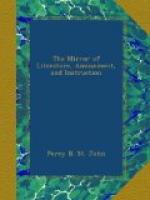Why are some resins odorous?
Because they contain essential oil; some afford benzoic acid when heated, and these have been termed balsams; such as tolu balsam and benzoin.
Common resin is obtained by distilling the exudation of different species of fir; oil of turpentine passes over, and the resin remains behind.
Why are the varieties of the cashew tribe, called varnish-trees?
Because their large flowers abound in a resinous, sometimes acrid, and highly poisonous juice, which afterwards turns black, and is used for varnishing in India. One kind is the common cashew nut. All these varnishes are extremely dangerous to some constitutions; the skin, if rubbed with them, inflames, and becomes covered with pimples that are difficult to heal; the fumes have also been known to produce painful swelling and inflammation.
Why do these varnishes, at first white, afterwards turn black?
Because the recent juice is an organized substance, consisting of an immense congeries of small parts, which disperse the sun’s rays in all directions, like a thin film of unmelted tallow; while the varnish which has been exposed to the air loses its organized structure, becomes homogeneous, and then transmits the sun’s rays, of a rich, deep, uniform, red colour.
The leaves of some species of Schinus are so filled with a resinous fluid, that the least degree of unusual repletion of the tissue causes it to be discharged; thus, some of them fill the air with fragrance after rain; and other kinds expel their resin with such violence when immersed in water, as to have the appearance of spontaneous motion, in consequence of the recoil. Another kind is said to cause swellings in those who sleep under its shade.—Brewster’s Journal.
Why is the soap-tree so called?
Because its bark, if pulverized, and shaken in water, soon yields a solution, frothing, as if it contained soap. It is a native of Chili; the trunk is straight, and of considerable height; the wood is hard, red, and never splits; and the bark is rugged, fibrous, of ash-grey colour externally, and white within.
Why is a species of myrtle called the wax-tree?
Because the leaves and stem, when bruised, and boiled in water, yield wax, which concretes on cooling. Mr. Brande observes, “the glossy varnish upon the upper surface of many trees is of a similar nature; and though there are shades of difference, these varieties of wax possess the essential properties of that formed by the bee: indeed, it was formerly supposed that bees merely collected the wax already formed by the vegetable: but Huber’s experiments show, that the insect has the power of transmuting sugar into wax, and that this is in fact a secretion.”
The wax-palm of Humboldt has its trunk covered by a coating of wax, which exudes from the spaces between the insertion of the leaves. It is, according to Vaquelin, a concrete, inflammable substance, consisting of 1/3 wax, and 2/3 resin.




